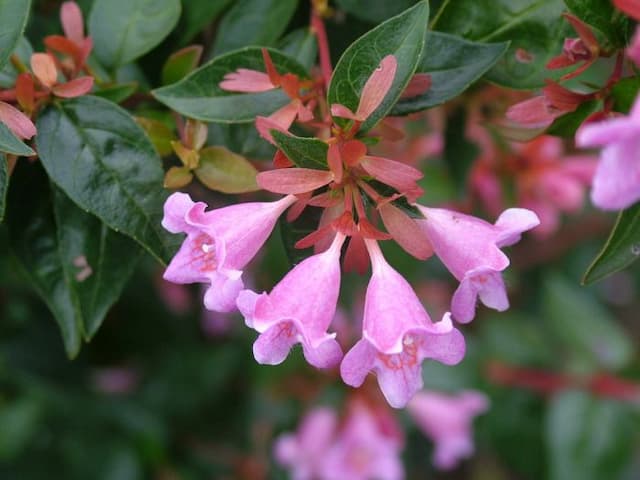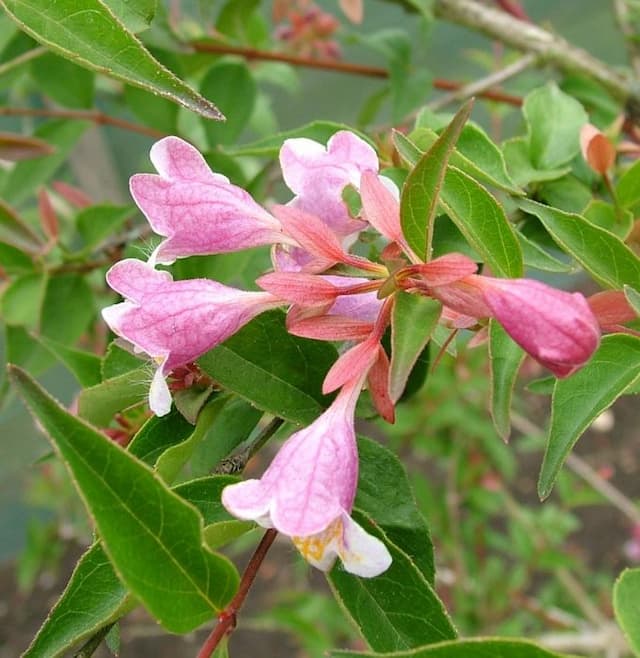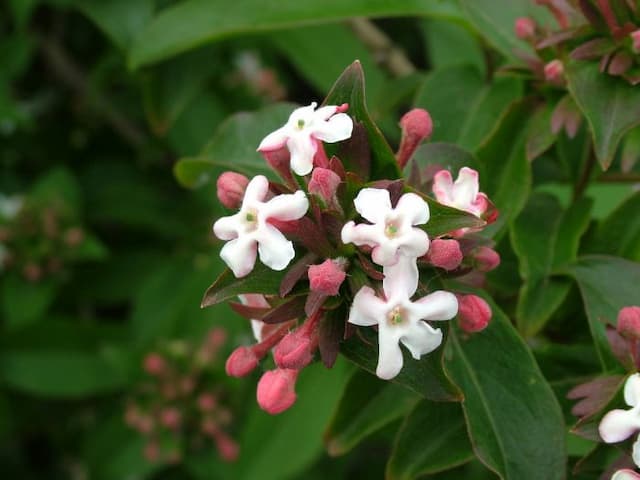Twinflower Linnaea borealis

ABOUT
The twinflower, as it is commonly known, is a charming and delicate plant that graces the forest floors of the northern latitudes with its presence. It bears a signature trait of twinning flowers, from which it derives its name. These blooms are enchanting, small, and bell-like in shape, often presenting in a soft, pale pink or sometimes with a closely akin white hue. The allure of the flowers is further accentuated by their delicate and inviting fragrance. The twinflower has a creeping habit, with slender, trailing stems that hug the ground, creating a carpet of greenery. Its leaves are small, rounded, and exhibit a deep green color with a glossy sheen, bringing a sense of vibrancy to its surroundings. During the blooming period, the plant is adorned with the twin flowers that are borne on slender, upright stalks, tenderly rising above the leafy backdrop. The subtle beauty of the twinflower lies in its simplicity and its testament to the often-overlooked splendor of the more modest plants of the forest floor. Its gentle aesthetic contributes to its allure and representation of the serene environments it inhabits.
About this plant
 Names
NamesFamily
Caprifoliaceae
Synonyms
Twinflower, Linnaea, Northern Twinflower, Twin Flower
Common names
Abelia corymbosa, Abelia linnaei, Caprifolium linnaei, Linnaea americana, Linnaea borealis var. americana, Linnaea borealis var. longiflora, Linnaea borealis var. procumbens, Linnaea corymbosa, Linnaea intermedia, Linnaea porsildii, Xylosteon linnaei.
 Toxicity
ToxicityTo humans
Twinflower is not commonly known to be toxic to humans. There are no significant reports of poisoning or adverse effects from ingesting or handling this plant. Always exercise caution and consult with a healthcare provider or a poison control center before ingesting any part of a plant that you are not familiar with.
To pets
Twinflower is not commonly known to be toxic to pets. There are no significant reports of pet poisoning or adverse effects from pets ingesting or coming into contact with this plant. Nonetheless, it is always prudent to monitor your pets around plants and contact a veterinarian if you suspect your pet has ingested something potentially harmful.
 Characteristics
CharacteristicsLife cycle
Perennials
Foliage type
Evergreen
Color of leaves
Green
Flower color
Pink
Height
4 inches (10 cm)
Spread
1 foot (30 cm)
Plant type
Shrub
Hardiness zones
2
Native area
Circumboreal
Benefits
 General Benefits
General Benefits- Ecosystem support: Linnaea borealis, commonly known as twinflower, provides nectar for pollinators such as bees and butterflies.
- Habitat provision: It offers cover and nesting opportunities for small ground-nesting animals and insects.
- Aesthetic appeal: With its delicate bell-shaped flowers and pleasant fragrance, twinflower adds beauty to forest floors and shaded garden areas.
- Erosion control: The plant's spreading habit and ability to form mats can help stabilize soil in areas prone to erosion.
- Cultural significance: Twinflower has historical value in various cultures and can be used in thematic gardens to represent certain traditions or historical periods.
- Education and research: As a circumpolar species, twinflower is used in studies relating to plant biology, ecology, and the effects of climate change on boreal species.
 Medical Properties
Medical Properties- This plant is not used for medical purposes.
 Air-purifying Qualities
Air-purifying QualitiesThis plant is not specifically known for air purifying qualities.
 Other Uses
Other Uses- Twinflower has been used as a flavoring agent in traditional Scandinavian fermented milk products, lending a distinct aroma and taste.
- In some cultures, the twinflower's delicate scent has been used in the making of perfumes and scented oils.
- The twinflower's aesthetic value makes it an attractive addition to ornamental gardens, particularly rock gardens and woodland settings.
- Artists and photographers often seek out twinflower for its picturesque qualities in botanical illustrations and nature photography.
- Due to its association with the Swedish botanist Carl Linnaeus, twinflower has historical value and is sometimes planted in botanical gardens as a tribute to his work.
- The long creeping stems of the twinflower have been used in weaving small traditional crafts and baskets in certain indigenous cultures.
- The plant has been incorporated into educational programs as an example of a circumpolar species and for teaching plant reproduction systems.
- Some Indigenous peoples have used twinflower in ceremonial rituals as a symbol of humility and devotion, due to its understated appearance.
- The nectar of the twinflower can be a food source for butterflies, making it a beneficial plant to include in butterfly gardens.
- Twinflower has been used in the craft of making natural dyes, where its parts may contribute subtle hues to fabrics.
Interesting Facts
 Feng Shui
Feng ShuiTwinflower is not used in Feng Shui practice.
 Zodiac Sign Compitability
Zodiac Sign CompitabilityTwinflower is not used in astrology practice.
 Plant Symbolism
Plant Symbolism- Enduring Love and Affection: Twinflower, the most common name for Linnaea borealis, often symbolizes enduring love and affection, as the plant has delicate yet persistent characteristics and the twin flowers often represent a perfect pair.
- Humility: This small and unassuming plant growing close to the ground is often associated with humility, reflecting its inconspicuous nature in the wild.
- Connection with Nature: Twinflower is found in northern forests and signifies a deep connection with nature and wild, untouched landscapes.
- Eternal Youth: The plant's association with Carl Linnaeus, who named it after himself, and his fondness for its beauty and simplicity, has led to its role as a symbol for eternal youth.
- Resilience: Despite its fragile appearance, the plant is hardy and capable of surviving in harsh climates, which symbolizes resilience and the ability to endure challenges.
 Water
WaterTwinflower should be watered regularly to maintain moist, but not waterlogged, soil. During active growth in the spring and summer, water the plant lightly with about 1/4 gallon once a week, increasing to twice a week during periods of drought or high heat. In the fall and winter, reduce watering to every other week, providing just enough to prevent the soil from drying out completely. Make sure to water the soil directly, avoiding wetting the leaves to prevent fungal diseases.
 Light
LightTwinflower prefers dappled sunlight or partial shade, thriving under the canopy of larger trees where it receives filtered light. Avoid placing it in direct, harsh sunlight, as it can damage the foliage. The best spot for this plant is an area where it will receive morning light and afternoon shade, mimicking its natural woodland habitat.
 Temperature
TemperatureTwinflower is hardy and adapted to cooler climates, ideally between 60 and 70 degrees Fahrenheit. It can survive minimum temperatures down to around 32 degrees Fahrenheit and maximum summer temperatures of up to 80 degrees Fahrenheit. Avoid exposing the Twinflower to sudden temperature changes or extreme heat to maintain its health and vigor.
 Pruning
PruningPruning Twinflower is generally not necessary, as it naturally maintains a compact form. However, if you wish to shape the plant or remove dead foliage, prune lightly in the spring just before new growth begins. This encourages a fuller plant and healthier growth. Pruning more than once a year is typically not required unless the plant becomes leggy or overgrown.
 Cleaning
CleaningAs needed
 Soil
SoilTwinflower prefers a soil mix that is well-draining with high organic content, similar to its native woodland habitat. The ideal soil pH for Linnaea borealis is slightly acidic, around pH 5.0 to 6.5.
 Repotting
RepottingTwinflower is not typically grown as a container plant and therefore doesn't require frequent repotting. In natural settings, Linnaea borealis does not need to be repotted.
 Humidity & Misting
Humidity & MistingTwinflower thrives best in a high humidity environment which mimics its natural humid forest habitat.
 Suitable locations
Suitable locationsIndoor
Provide bright, indirect light and keep soil lightly moist.
Outdoor
Plant in dappled shade with moist, organic-rich soil.
Hardiness zone
2-7 USDA
 Life cycle
Life cycleTwinflower (Linnaea borealis) begins its life cycle as a seed, which requires a period of cold stratification to break dormancy and germinate. Upon germination, a seedling emerges and develops a set of true leaves, beginning the vegetative growth phase during which it establishes a root system and grows a trailing stem. The plant enters a period of vegetative growth, spreading through rhizomes and forming a mat-like ground cover in its preferred shady forest habitat. When mature enough, usually in late spring to summer, it produces small, fragrant, bell-shaped flowers that are usually pinkish-white, found in pairs, hence the name twinflower. After pollination, often by insects attracted to its scent or birds, the flowers develop into dry, capsule-like fruits that disperse seeds for the next generation. Twinflower is perennial, so this reproductive cycle repeats annually while the overall plant can live for several years, spreading vegetatively and through seed propagation.
 Propogation
PropogationPropogation time
Spring to Summer
The most popular method of propagation for the twinflower, Linnaea borealis, is by taking semi-ripe stem cuttings during the late summer months. To do this, one should choose a healthy, non-flowering stem and cut a segment about 2 to 4 inches (5 to 10 cm) long, just below a leaf node. The lower leaves should be removed, and the cut end of the stem can be dipped in rooting hormone to encourage root development. The cutting should then be placed in a pot with moist, well-draining soil, ensuring that the remaining leaves are above the soil surface. The pot should be kept in a warm, indirect light setting and the soil should be kept consistently moist but not waterlogged. Roots typically begin to develop in a few weeks, and once they are sufficiently established, the new plant can be transplanted to a more permanent location.








![Himalayan honeysuckle [Golden Lanterns]](/_next/image?url=https%3A%2F%2Fplants-admin.emdemapps.com%2Fimages%2Fplants%2F%2Fimages%2F604b55302cc87.png&w=640&q=75)
